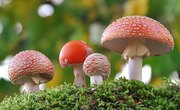
All of the living things of Earth have one thing in common: They’re alive. But as you might have guessed, the millions of living organisms on Earth have plenty of unique characteristics and compositions that make them quite different than their fellow living beings. To help break down all the different types of life on the planet, scientists have divided that life into six kingdoms. Having an understanding of the 6 kingdoms and examples of the life forms in each group can help you appreciate all the different types of life that you come into contact with every day.
TL;DR (Too Long; Didn't Read)
The six kingdoms of life are Animalia, Plantae, Archaebacteria, Eubacteria, Fungi and Protista.
A Breakdown of Kingdom Biology
Of the 6 kingdoms of life, the two most well-known are probably Animalia and Plantae, or animals and plants. Some of the main separating characteristics of animals are that they are multicellular and heterotrophs, which means they rely on other organisms for food. Animals include creatures who exist on land all over the planet, such as:
- lions
- elephants
- dogs
- birds
- rodents
- snakes
It also includes those who swim through life, like fish, dolphins, sea turtles and sharks.
Archaebacteria and Eubacteria
There are two kingdoms not always visible to the naked eye. They are archaebacteria and eubacteria. They’re organisms that you probably encounter frequently, and some even live inside your body. But unlike a plant or an animal, you may have no idea when you’re touching or seeing them, often because they are too small to see.
Archaebacteria are single-celled, and they don’t have a cell nucleus. They’re also able to survive in harsh environments like volcanic hot springs or salt lakes. For that reason, they are likely the oldest surviving kingdom of life. They are grouped into categories like methanogens and thermoacidophiles. As the name suggests, methanogens produce methane, which is why they are commonly used to treat wastewater. Thermoacidophiles can live in environments that are both very hot and very acidic, such as deep sea vents and hot springs.
You probably encounter eubacteria more often than you do archaebacteria. A diverse group of bacteria belongs to the Eubacteria kingdom. Some, like bacilli and spirilla, can lead to harmful strains of E. coli or cause unpleasant diarrhea when consumed. For this reason, eubacteria often gets a bad reputation for spreading disease. And while some do, there are also plenty of eubacteria that are essential for life on Earth. An example is cyanobacteria, sometimes referred to as blue-green algae, which many scientists believe helped convert Earth’s atmosphere from one without enough oxygen into our current oxygen-rich environment, where so many organisms can thrive.
Fungi and Protista
Another kingdom of life is the Fungi kingdom. Many fungi are similar in appearance to plants, but like animals, most cannot make their own food and usually have to absorb nutrients from an outside source. You may already know that mushrooms are fungi. There are several other types of fungi, too, like yeasts and molds. Some, like ringworm, can cause diseases in humans. But others, like penicillium, are important in creating antibiotics that fight off illness.
The final kingdom, Protista, is a miscellaneous group of mostly single-celled organisms that don’t quite fit into the other five kingdoms. One example is seaweed. Although many people think of seaweed as a plant, the underwater organisms lacks the cell structure of a true plant.
The 6 kingdoms' characteristics are diverse, but understanding each kingdom’s uniqueness can help you realize how many incredible life forms exist on the planet.
References
About the Author
Rachelle Dragani is a freelance writer based in Brooklyn with extensive experience covering the latest innovation and development in the world of science. Her pieces on topics including DNA sequencing, tissue engineering and stem cell advances have been featured in publications including BioTechniques: the International Journal of Life Science Methods, Popular Mechanics, Futurism and Gizmodo.
Photo Credits
Ryan McVay/Photodisc/Getty Images
